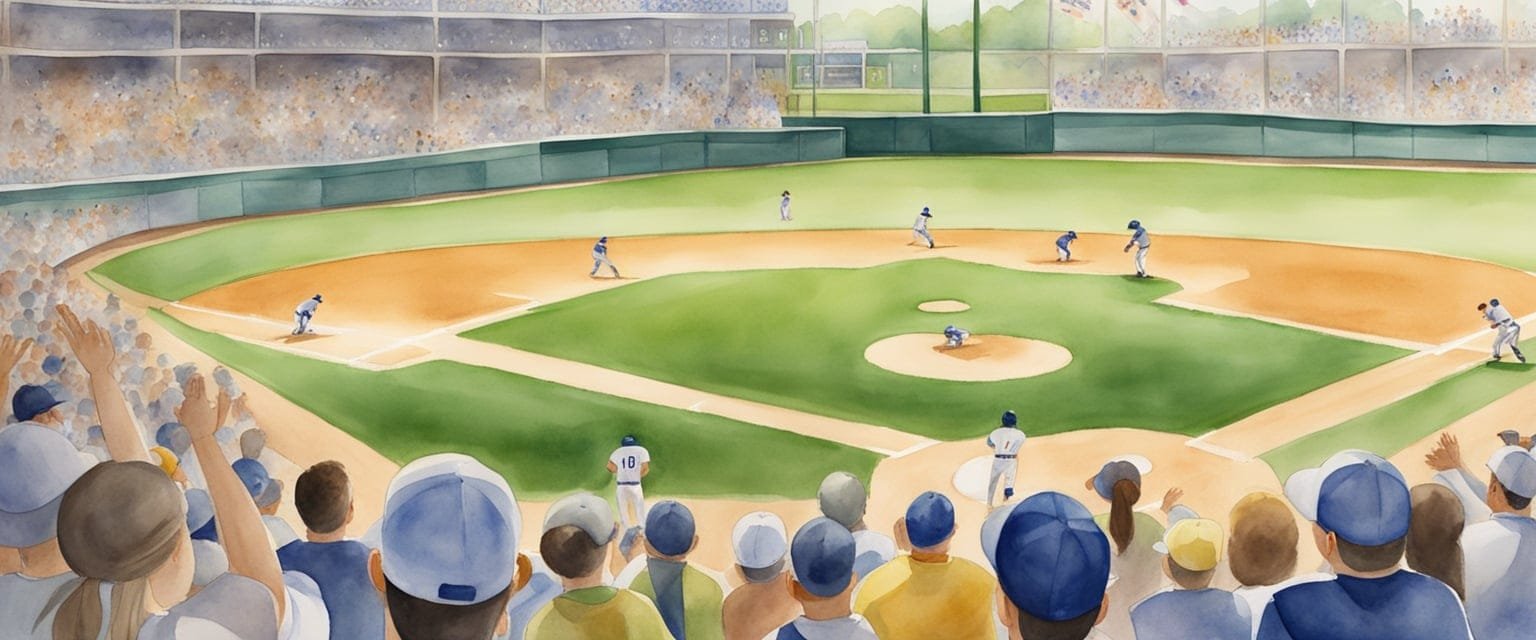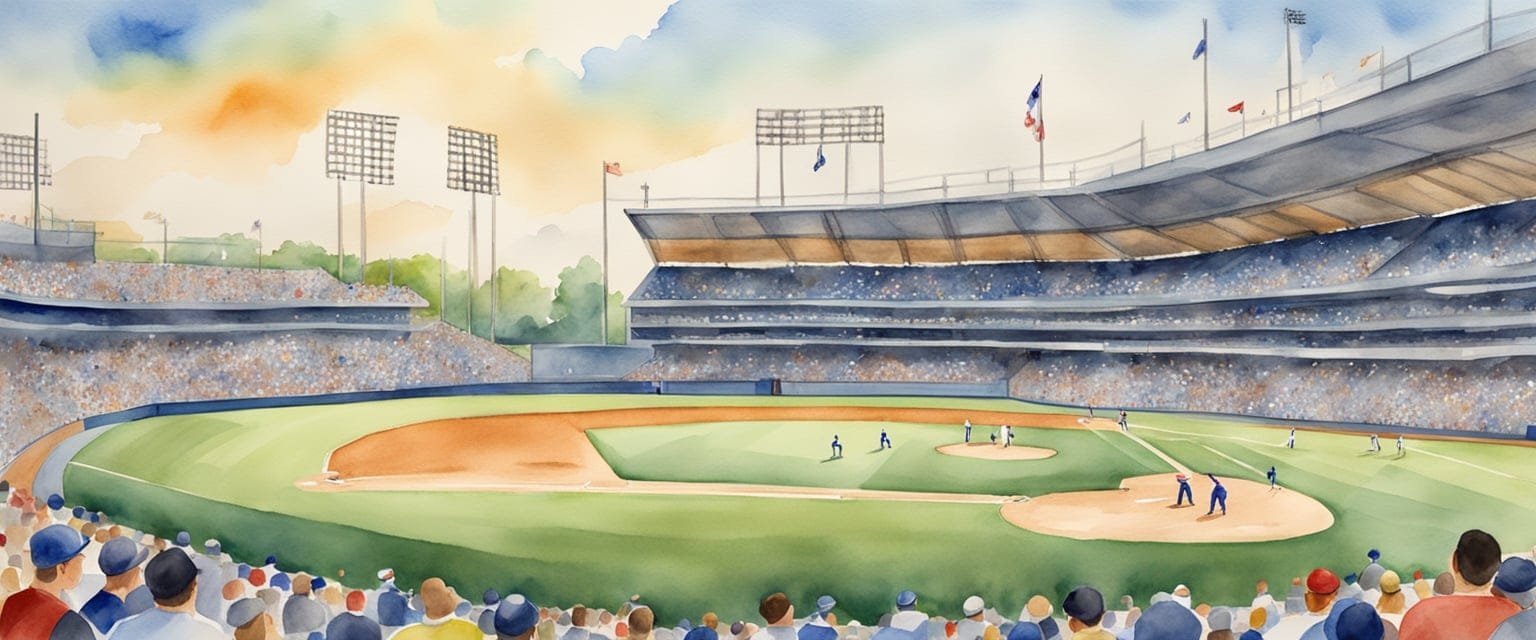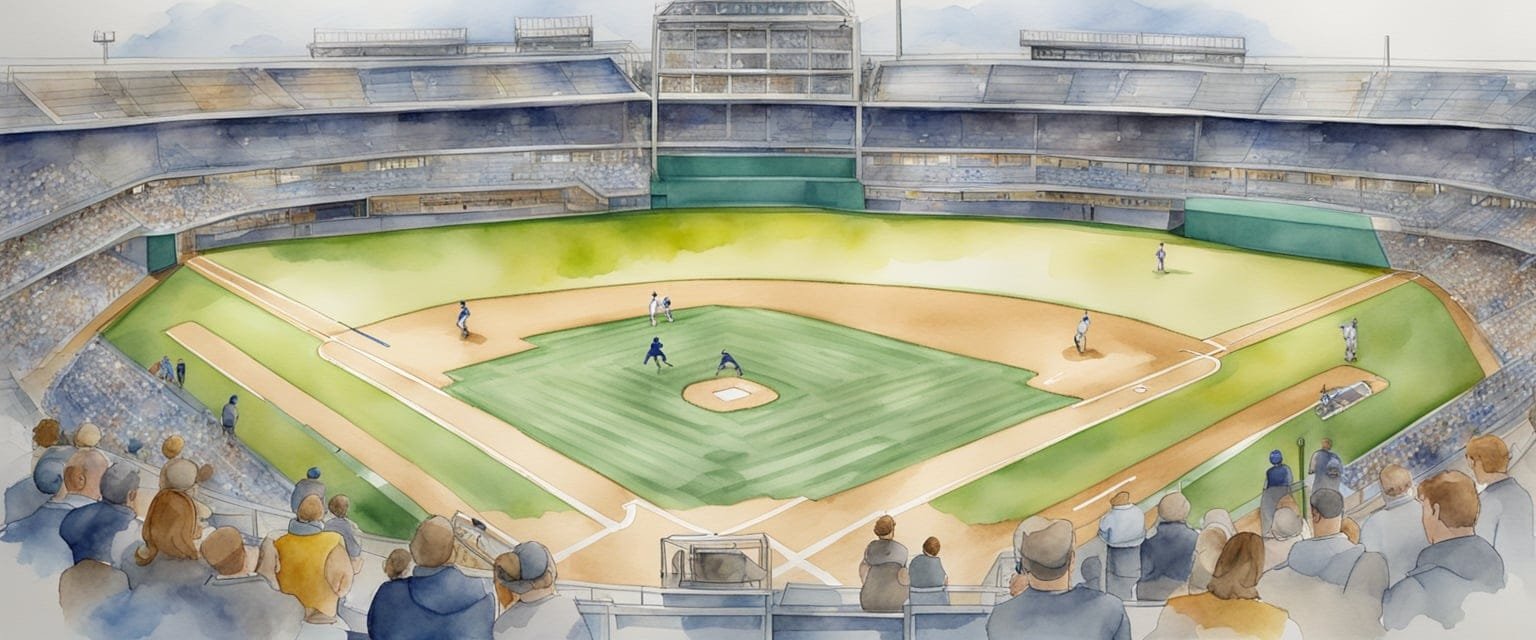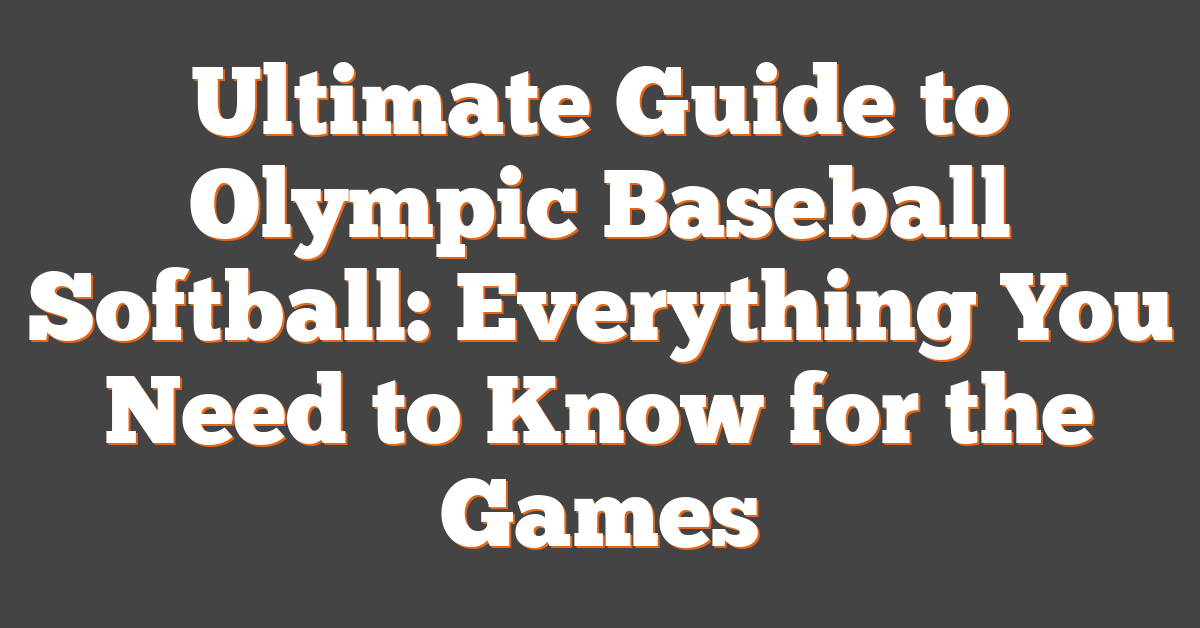The excitement of Olympic Baseball and Softball captures the spirit of competition and teamwork. In this ultimate guide, I will explore the history, players, and unique features that make these sports special in the Olympic Games. From their journey back into the spotlight during the Tokyo 2020 Olympic Games to innovations shaping the future of the game, there’s so much to discover.

As I dive into the different tournaments and their iconic venues, you’ll learn about the key teams to watch and the athletes making a mark in the sport. From unforgettable moments in Olympic history to the behind-the-scenes action, I aim to provide a comprehensive view that enhances your understanding of these exciting games.
Join me as we celebrate the vibrant world of Olympic Baseball and Softball, uncover what makes these sports unique, and look forward to their future in the Olympics.
Key Takeaways
- Olympic Baseball and Softball have a rich history full of dramatic moments.
- Key athletes and teams have defined the legacy of these sports.
- Technology continues to impact how the games are played and experienced.
History and Evolution of Olympic Baseball and Softball
I find it fascinating how baseball and softball have developed over time, especially their journey to the Olympic stage. They both have rich histories and have seen various changes in their status in the Olympic Games.
Origins of Baseball and Softball
Baseball originates from 19th-century America. George Hancock is credited with creating a similar game called “Indoor Baseball” in 1887. This laid the groundwork for baseball as we know it today.
Softball emerged shortly after in 1887 as well. The game was invented in Chicago during a Thanksgiving Day gathering. Over time, it evolved from a recreational activity to a competitive sport.
Both of these games have deep roots in American culture and have spread across the globe, becoming beloved sports in many countries.
Inclusion in the Olympic Program
Baseball made its Olympic debut in 1900 during the Paris Games. It was a demonstration event and only featured male athletes. Softball joined the Olympics much later in 1996 at the Atlanta Games, representing women’s sports on an international platform.
Baseball continued through various Olympics, but was removed after the 2008 Beijing Games. Softball faced a similar fate, being dropped after the 2008 Olympics as well. It wasn’t until Tokyo 2020 that both sports made a comeback, showcasing their global appeal.
Atlanta 1996 to Tokyo 2020: A Timeline
- Atlanta 1996: Softball becomes an official Olympic sport, leading to the USA winning its first gold.
- Sydney 2000: Team USA captures gold again, defeating Australia in the final match.
- Athens 2004: The USA wins another gold, cementing their dominance.
- Beijing 2008: This is the last time both softball and baseball appear in the Olympics for a period of time.
Years later, in Tokyo 2020, baseball and softball return, introducing new formats and excitement. Countries like Japan and the USA became prominent contenders, showcasing their skills once more.
Notable Olympic Moments
There have been many memorable moments in Olympic baseball and softball. The USA’s three consecutive gold medals in women’s softball stand out.
In baseball, Cuba has had a significant impact. They won gold in 1992 and 1996, showcasing their exceptional talent. The match between Japan and the USA in the Tokyo 2020 Olympics was thrilling. Japan won gold at home, ending the event with great excitement and national pride.
These moments not only highlight the competitive spirit of the athletes but also the lasting legacy of baseball and softball in Olympic history.
Understanding the Game
Baseball and softball are both popular sports that share many similarities but also have key differences. In this section, I will discuss the basic rules and regulations of each game, highlight their differences, explain gameplay structure, and outline player positions and roles.
Basic Rules and Regulations
In both baseball and softball, the objective is to score runs by hitting the ball and running around bases. Each game consists of innings, where teams take turns batting and fielding. Baseball games typically last nine innings, while softball games are played for seven innings.
Each inning is divided into two halves: the top half and the bottom half. The visiting team bats in the top half, while the home team bats in the bottom half. When a team gets three outs, the teams switch roles. Important rules include the need for the batter to hit the ball within the strike zone and the pitcher needing to throw within the official baseball and softball rules to ensure fair play.
Differences between Baseball and Softball
While both sports share a diamond-shaped field and similar gameplay, key differences exist. One of the main differences is the way the ball is pitched. In softball, pitchers throw the ball underhand from a distance of 43 feet. In baseball, the pitcher throws overhand from 60.5 feet.
The balls used in each sport are also different. A baseball is smaller and harder than a softball, which is larger and softer. Additionally, the base paths in softball are typically shorter. While baseball uses a designated hitter, this rule may vary in softball, depending on the league.
Gameplay: Innings and Scoring
As mentioned earlier, baseball has nine innings, and softball has seven. The way scoring is achieved is similar in both sports. A team scores a run when a player successfully touches home plate after touching all four bases: first, second, third, and home.
In both games, strategies like bunting and stealing bases can influence scoring. The team with the most runs at the end of the game wins. If the game is tied after the last inning, extra innings may be played to determine the winner.
Positions and Player Roles
Each team consists of nine players in baseball and ten in softball. Here are the key positions:
- Pitcher: Throws the ball to the batter and tries to get outs.
- Catcher: Catches pitches and plays behind home plate.
- Infielders: Includes first basemen, second basemen, shortstop, and third basemen who field balls hit near the bases.
- Outfielders: Positioned in the outfield to catch fly balls and stop runners from advancing.
In softball, a designated hitter may replace a player in the batting lineup. Understanding these positions helps fans appreciate the strategies involved. Each player has a specific role that contributes to the team’s success, making teamwork crucial in both sports.
Key Olympic Tournaments and Their Venues

I find it exciting to explore key tournaments for baseball and softball at the Olympics, especially with their return at Tokyo 2020. Let’s look at the details of this event and the iconic venues that have hosted these thrilling competitions.
Tokyo 2020: Baseball and Softball Returns
Tokyo 2020 marked the return of baseball and softball to the Olympic stage after their last appearance in Beijing 2008. The baseball tournament ran from July 28 to August 7, while the softball tournament took place from July 21 to 27.
The venues for these events included Fukushima Azuma Baseball Stadium and Yokohama Stadium. The selection of Fukushima was significant, showing the region’s recovery following the 2011 disaster.
Teams like Japan, USA, and Korea competed fiercely, showcasing top-notch athletes. The matches drew attention not just for the sport, but also for the cultural excitement surrounding Japan’s love for baseball.
Iconic Stadiums in Olympic History
Various stadiums have set the stage for baseball and softball in past Olympic Games. Each venue has its unique story that contributes to the Olympic spirit.
In Tokyo, Fukushima Azuma Baseball Stadium played a critical role. It became a symbol of resilience and hope for the local community. Yokohama Stadium is another legendary site, known for its vibrant atmosphere and rich baseball history.
Looking back, other notable Olympic baseball venues include Beijing’s Wukesong Stadium and Atlanta’s Turner Field. Each stadium has hosted exciting moments, connecting fans to extraordinary athletic accomplishments.
These venues highlight the importance of place in Olympic history and the excitement they bring to the games.
Teams and Players to Watch

As I explore Olympic baseball and softball, certain teams and players stand out. There are powerhouse nations known for their skill and history in the sports, as well as emerging talents that can surprise everyone. Here’s a look at the teams and athletes to keep an eye on.
Dominant Countries in Olympic Baseball and Softball
When it comes to baseball and softball, a few countries consistently perform at the top level.
For baseball, the United States has long been a strong contender, holding the title of Baseball’s World No. 1. They have multiple Olympic medals and a lot of experience.
Japan is another top team, celebrated for their strong pitching and discipline. They aim to defend their gold from Tokyo 2020.
In softball, the USA has dominated, being Softball’s World No. 1 and winning numerous Olympic titles.
Other noteworthy nations include Australia and Canada, which regularly show strong performances and produce talented players.
Star Athletes and Their Achievements
The Olympics often feature outstanding athletes who inspire many. One player to watch is Mike Trout from the USA. He’s known for his incredible batting skills and speed.
Another key figure is Yukiko Ueno from Japan, a legendary pitcher with a strong winning record. She has proven herself on the world stage and is a critical asset to her team.
Monica Abbott, an American softball pitcher, has also made a name for herself with her powerful throws and leadership. Her experience could be vital for the USA team.
Emerging athletes such as Juan Soto from the Dominican Republic are also promising. Soto is young but already has impressive achievements in Major League Baseball.
Emerging Nations and Underdogs
While powerhouse teams often dominate, some emerging nations are making waves in Olympic baseball and softball.
Mexico, for instance, has shown significant growth in talent and competitiveness. They have a solid roster and could challenge stronger teams.
Italy is another nation worth watching. Their players have made strides in international competitions and may surprise opponents.
Countries like Israel and Korea have also built strong programs. Israel’s diverse talent and Korea’s disciplined approach both create potential for upset victories.
It’ll be exciting to see how these emerging teams perform against the traditional powerhouses.
Olympic Baseball and Softball Tournaments
In the Olympic Games, both baseball and softball feature exciting tournaments packed with competition. Understanding the qualification process, tournament format, and medal rounds is essential for fans and athletes alike.
Qualification and Tournament Format
Qualification for the tournaments varies. For baseball, teams must earn spots through regional qualifiers, while softball often includes one or two qualifying events. The top teams from these events secure a place in the Olympic tournament.
Both tournaments use different formats. Baseball features 9-inning regulation games with 24-player rosters. Softball, on the other hand, has 7-inning regulation games and 15-player rosters. The opening round typically involves a round-robin play, where each team competes against all others in its group. This ensures an exciting atmosphere as teams vie for the top spots.
Gold Medal Game
The Gold Medal Game is the culmination of the tournament. It features the top two teams, determined by performance in the knockout round or the group stage. This thrilling game is the ultimate test of skill and teamwork.
Each match leading up to the Gold Medal Game is crucial. The teams must showcase their best abilities and make strategic decisions to reach this final stage. Winning this game is highly prestigious, as it not only secures the Gold Medal but also cements a place in Olympic history.
Knockout Rounds and Medals
After the opening round, the knockout rounds begin. The top teams progress to these intense matches where a single loss means elimination. Teams must be in top form, focusing on their strategies and execution.
The knockout rounds lead to other significant matchups, including the Bronze Medal Game. This final contest allows teams that lost in the semifinals to compete for one last chance at Olympic glory. Championships in both baseball and softball have become unforgettable moments, celebrated by athletes and fans alike.
Olympic Tournaments: Behind the Scenes

Planning and executing Olympic baseball and softball tournaments involves various aspects. From how tournaments are organized to the way fans engage with the events, many details are crucial for a successful experience.
Organizing Committees and Management
The management of baseball and softball events falls under the responsibility of the World Baseball Softball Confederation (WBSC) and the organizing committees of the host city. They work collaboratively to ensure everything runs smoothly according to the Official Olympic Baseball and Softball Tournament Regulations.
These committees handle logistics, including venue selection, team accommodations, and event scheduling. They also coordinate with local authorities to ensure safety and security for players and fans. Their goal is to create an exciting atmosphere that showcases the best athletes in the world.
Media Coverage and Broadcasting
Media coverage plays a significant role in how fans experience the Olympics. Major broadcasters like NBC ensure that every pitch, hit, and catch reaches viewers. They provide live broadcasts, highlight reels, and in-depth analyses of the games.
With so many platforms available, fans can enjoy coverage on TV, online streaming, and social media. This availability makes it easier for baseball and softball enthusiasts to follow their favorite teams and players. The focus on storytelling in broadcasts also helps fans connect more deeply with the athletes’ journeys.
Spectator Experiences and Fan Engagement
Creating a memorable experience for spectators is essential during the Olympics. Organizers focus on fan engagement through various means. For instance, they enhance stadium environments with entertainment and food options that reflect local culture.
Interactive experiences like player meet-and-greets, merchandise stalls, and viewing parties allow fans to feel involved. This engagement can make them feel like they are part of the event, not just observers. The lively atmosphere gives spectators a unique opportunity to celebrate the spirit of baseball and softball together.
Technological Advancements and Innovations

In baseball and softball, technology is changing how the games are played and officiated. I find these advancements fascinating as they enhance player safety, performance, and even the fan experience. Here are some key areas where technology has become a game changer.
Equipment and Apparel
Modern equipment has made a noticeable impact on performance. The Official Ball used in competition has improved with design changes for better grip and durability. For instance, the SSK WBSC 540 baseball and the Mizuno 150 softball are specially designed to optimize hitting and pitching.
Apparel has also evolved to enhance player safety and comfort. Many uniforms now incorporate moisture-wicking fabrics and advanced padding. This helps reduce injuries while keeping players cool during intense games. It’s all about maximizing performance and ensuring that athletes can focus on the game.
Sports Analytics in Baseball and Softball
Analytics play a critical role today, influencing coaching decisions and player strategies. I enjoy seeing how stats like launch angle and exit velocity can change how players train and prepare for competition. Coaches now use data to enhance game strategies, including how they approach batting and pitching.
Tools like video analysis software allow players to study their performance closely. They can track improvements over time and identify areas for growth. This data-driven approach is transforming how athletes prepare, leading to enhanced efficiency and better results on the field.
Umpiring and Video Review Systems
Umpiring has greatly benefited from technology. With the Umpire Video Review system, teams now have a way to challenge calls made during the game. This is revolutionary for ensuring fair play and reducing errors.
The 20-Second Clock Between Pitches has also been introduced to speed up the game, keeping the action lively. Managers have the option to challenge specific plays, which adds an exciting layer to the sport. The introduction of an Extra-Inning Tie-Breaker rule further enhances gameplay dynamics, making every inning count.
These technologies work together to create a better experience for everyone involved—players, coaches, and fans alike. I find it exciting to see how these advancements continue to shape the future of baseball and softball.
Looking Ahead: The Future of Olympic Baseball and Softball
The return of baseball and softball to the Olympics in 2028 is something I am really excited about. This will take place during the Summer Games in Los Angeles, which is a fantastic opportunity for these sports.
As I look at the Olympic Program, I see some changes that will make the game more interesting. There’s talk of a Designated Player Allowed rule, which can add a new layer of strategy. This rule could let teams use a player specifically for batting, which may bring more action to the game.
The Run-Ahead Rule is another exciting aspect. It allows a game to end early if one team is ahead by a certain number of runs. This could lead to quicker games and more time for fans to enjoy other events.
Thinking about the history of baseball, I remember the National Association of Professional Base Ball Players founded in Surrey, England, which showed how far the sport has come. It started with just nine players on the field, and now we have more complex teams and strategies.
For softball, the Windmill Pitch technique continues to be popular. It is impressive to watch skilled players execute this and could draw in more fans.
I believe these changes can bring new excitement to baseball and softball, making them standout events during the Olympics.
Frequently Asked Questions

I understand that you may have some questions about Olympic baseball and softball. Here, I will address common inquiries regarding qualification, past winners, schedules, and rules for these exciting events.
How can one qualify for the Olympic baseball and softball games?
Qualification for the Olympic baseball and softball games usually involves various international tournaments. Each region has its own qualifying events leading up to the games. Teams must perform well in these competitions to secure their spot in the Olympics.
Who were the past winners of the Baseball Olympics?
The Olympic baseball tournament has seen several winners since it was first introduced. Countries like the USA, Cuba, and Japan have often been strong contenders. I can look into specific years and details of past champions if you’re interested!
What is the complete schedule for the baseball events in the upcoming Olympics?
The complete schedule for baseball events is typically released closer to the Olympic Games. It includes dates, times, and venues for each match. I recommend keeping an eye on the official Olympic website for updates as the event approaches!
Will there be any restrictions on professional baseball players participating in the Olympics?
There have been discussions about the participation of professional baseball players in the Olympics. Each country may have its own rules regarding which athletes can compete. Generally, many top players do participate, but it’s best to check the latest guidelines as the Olympics near.
What are the rules and regulations for softball at the Olympics?
Softball at the Olympics follows specific rules set by the International Softball Federation. These rules cover everything from gameplay to team compositions. I can share more details about gameplay rules or field dimensions if you’d like!
Has the list of teams competing in Olympic baseball been announced?
The list of teams competing in Olympic baseball is usually revealed after the qualification tournaments are completed. Countries must earn their places through these events. Keeping an eye on the official Olympic updates will provide the latest information on the teams participating.

